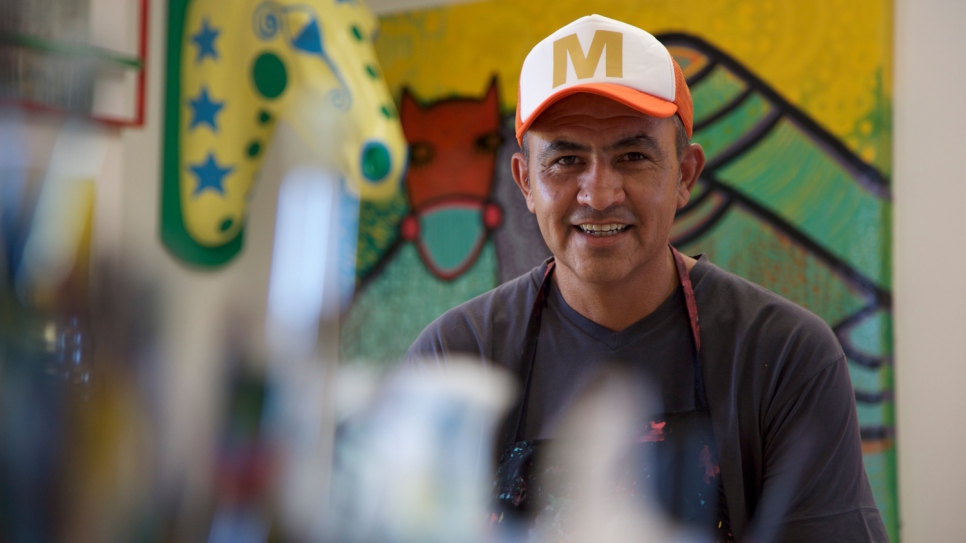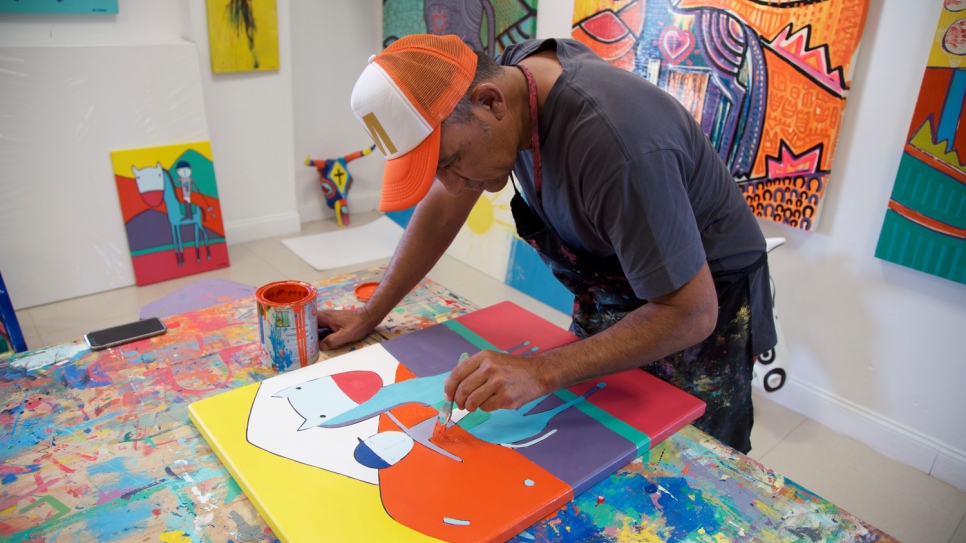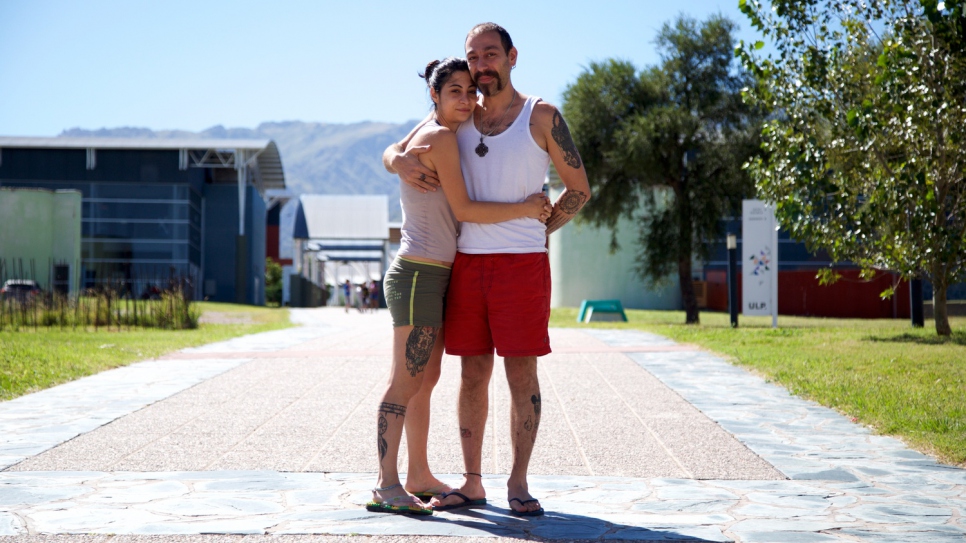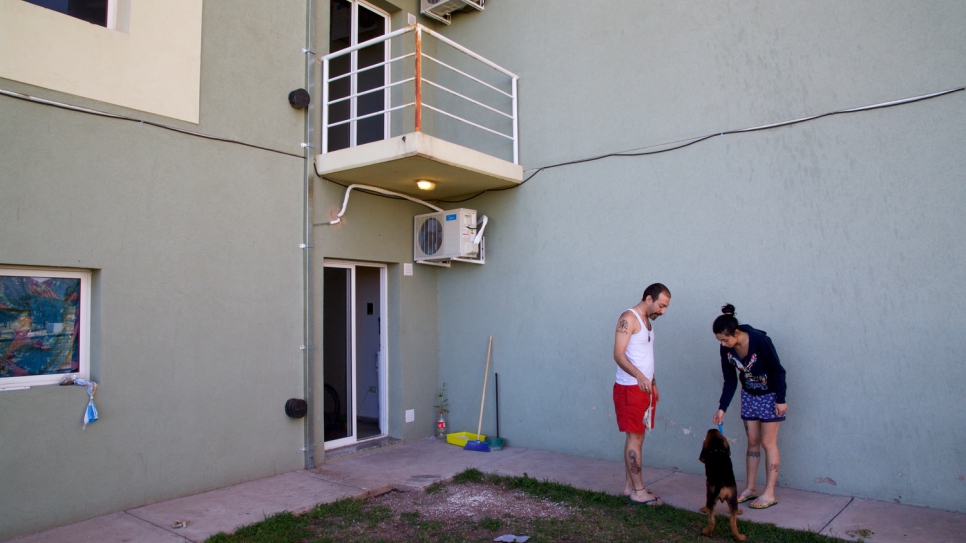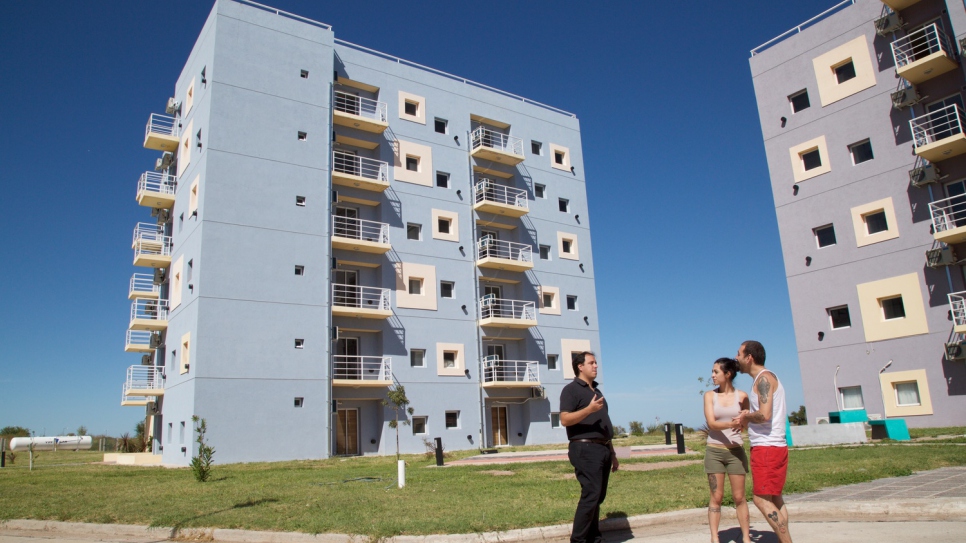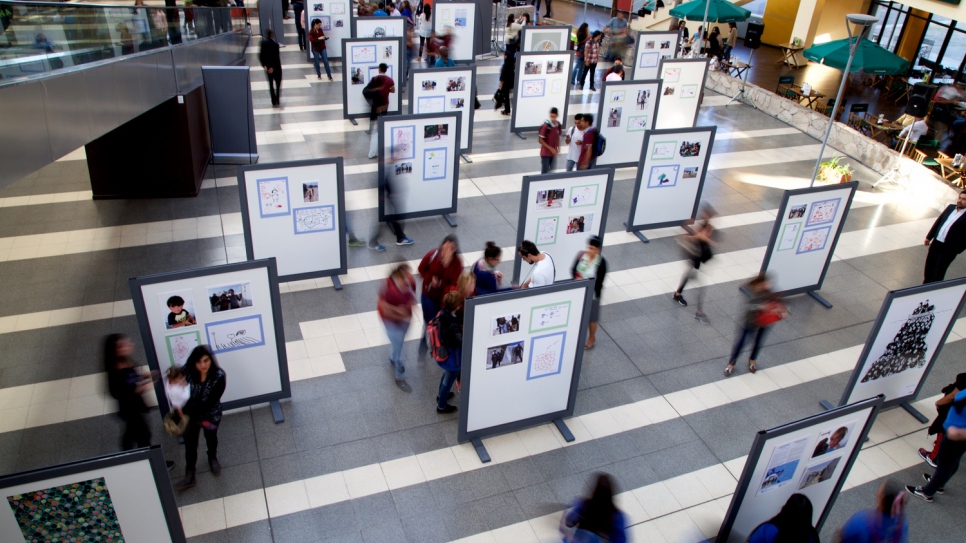Escaping war at home, Syrian couple start over in Argentina
Majd and Lana fled fighting in Damascus. Now they have found hope and a fresh start in provincial San Luis.
Majd and Lana pose with their bicycles outside their apartment block in San Luis, central Argentina.
© UNHCR/Jack Aldwinckle
On a warm weekday afternoon, the Argentine city of San Luis is an oasis of calm. Majd and Lana, married Syrian refugees from Damascus, are killing time before their Spanish lesson. It is hard to believe they only arrived here five weeks ago.
“It already feels like home,” grins Lana. “In Argentina we have learnt how to be human again,” adds Majd, taking a deep drag on his cigarette.
The couple had little choice but to flee Syria. Two years earlier Majd, a cook, narrowly escaped with his life after a bomb hit his parents' home in the Old Town of Damascus. He and Lana, a sculptor, got married and bought a flat further from the city centre. But it quickly became “the most dangerous neighbourhood in the whole city,” remembers Majd. “Everyone was scared.”
In February 2017, they arrived in the central province of San Luis under a humanitarian visa programme for Syrian refugees offered by the Government of Argentina. The tranquillity of the provincial capital, also called San Luis, is in stark contrast to the death and destruction of Damascus. With a population of 200,000 people, its streets thrum with activity in the morning; in the afternoon most shops close while locals take a siesta, or afternoon nap.
More than 8,000 miles from home, the couple are flourishing. As the first Syrian refugees to arrive in the province in central Argentina, they have become celebrities. They are even starting to get recognised on the street. “Sometimes I feel like a Pokémon,” laughs Majd.
"In Argentina we have learnt how to be human again."
Established in 2014, Argentina’s humanitarian visa programme offers a vital escape route to those fleeing Syria’s war. It requires Argentine citizens, organizations or institutions to act as sponsors and commit private funds to provide newly-arrived refugees with accommodation and financial assistance.
San Luis has gone one step further. It is the first province to pledge public funds to support the resettlement of at least 50 families in the province, 30 of whom will be selected by the UNHCR, the UN Refugee Agency. Those who are resettled are offered free Spanish lessons, accommodation, further education (including the option of studying for a university degree), health insurance and public transport. They also receive two years’ worth of financial support to help them adjust to their new life in Argentina, while they find a job.
The offer came just in time for Lana and Majd. Many of their friends were killed after being conscripted into the Syrian army. Countless others died in the fighting. As the violence worsened, the couple considered fleeing overland to Europe.
But their religion – both are Orthodox Christians – made the journey impossible. The route, through Idlib or Aleppo, would have brought them into contact with extremist militias, who would have killed them for their faith. Concealing it was not an option: Majd has a crucifix prominently tattooed on his right forearm.
Once accepted onto Argentina’s humanitarian visa programme, the couple left Damascus and flew to Buenos Aires. After arriving in Argentina the couple enjoyed practising their religion freely. “We cried when we went to our first church service,” says Lana. They often pray in their new flat, part of a student accommodation block at the University of La Punta, a half-hour drive from the city of San Luis.
The couple is settling in well. They share their flat with Blackie, a rambunctious puppy gifted to them by the provincial governor, Alberto Rodríguez Saá. Twice a week they take the bus into the city for a Spanish class with Claudia, their teacher. They are making extraordinary progress. “We understand everything, we just don’t have the vocabulary to be able to respond yet,” explains Lana.
Locals are eager to help. Under the relocation scheme, the province’s residents are encouraged to offer practical support to the new arrivals. Many are stepping forward. Linguists can volunteer as translators, entrepreneurs can offer jobs, even families can find a way to help. “They can meet for dinner together or celebrate a birthday,” explains Liliana Scheines, who co-ordinates the Syrian Refugee Committee, which operates the provincial programme named 'Humanitarian Corridor San Luis'.
Mario Lange is one of those to put his name forward. An artist with a workshop on the edge of town, his bright and colourful paintings and murals also adorn San Luis’s public buildings. He sympathises with Majd and Lana’s predicament. “I was born into extreme poverty,” he explains. “I lived in the middle of the countryside and when I came to San Luis it was tough.”
“The plan is to receive four or five families every couple of months."
Shortly after their arrival, Mario invited Lana along to help him with a public art installation and presented the couple with a pair of hand-painted bicycles. He warns that adjusting to life in San Luis take time. “After few weeks they will begin to realise they are in another country. That’s when they will really need our help.”
In a speech to the UN General Assembly in New York on September 20 last year, Argentine President Mauricio Macri, pledged to resettle 3,000 Syrian refugees. Priority would be given to families with young children, he announced. “The images we are witnessing hurt and worry us,” he told world leaders. “Reality compels us to do more.”
In San Luis, the scheme is only just getting started. “The plan is to receive four or five families every couple of months,” says Scheines. The ambition is to settle them in 60 of the province’s municipalities to better integrate them with San Luis’s residents.
UNHCR believes more needs to be done to help some five million Syrian refugees, uprooted by six bloody years of conflict. The provincial government is winning plaudits for its progressive approach. “It’s an amazing programme,” says Michele Manca di Nissa, Regional Representative for UNHCR’s southern Latin America office. “We hope it can be a model for other provinces in Argentina and other countries in the region.” The regional office is advising the province on local integration issues and raising awareness of refugees by organising workshops for journalists and mounting 'RefugiArte', a touring art exhibition.
Majd and Lana have not forgotten about Syria. They use social media to follow the news and keep in touch with friends and family. The couple hope to help some of them follow in their footsteps. Their parents “are too old” to leave Syria, says Lana. But some cousins are interested. Majd and Lana are collating their names and passing them onto the Argentine authorities. “It’s like a chain," explains Lana. “We are to trying to help as many as we can.”
The couple are brimming with optimism about their future. Lana hopes to find work as an artist and Majd, an enthusiastic cook, would like to open a restaurant one day. “We are going to start again and be successful,” declares Lana. They are determined to build a new life in Argentina. “This is our home now,” says Lana, squinting at the jagged foothills of the Andes in the distance. “I can’t imagine going back to Syria.”

